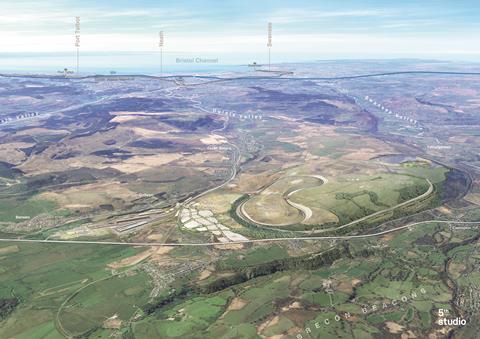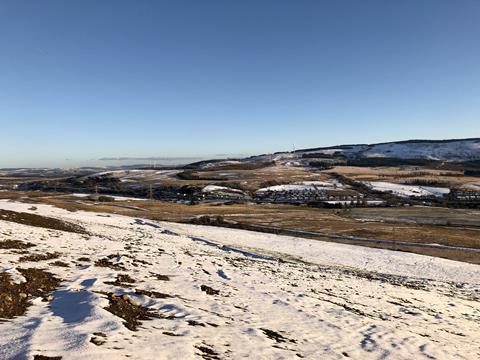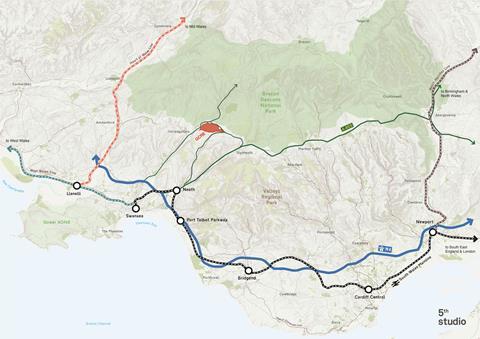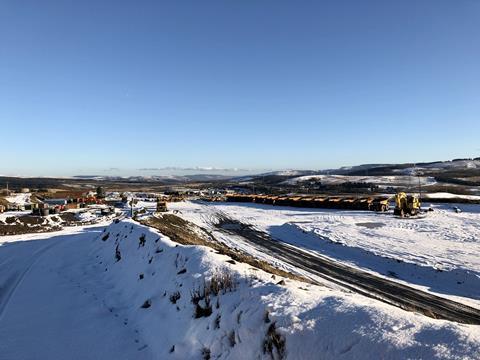
UK: ‘We are offering a live business to the market, not a set of plans on paper’, said GCRE Ltd Chief Executive Simon Jones when he welcomed guests to the site of the Global Centre of Rail Excellence at Onllwyn in South Wales on January 20.
His comment reflected the formal launch the previous day of procurement to secure outside investment to take plans forward for the rail research and renewable energy hub on the site of a former opencast coal mine 15 km north of Neath.
The Welsh government-owned GCRE Ltd has issued a formal notice via the UK’s procurement portal seeking a ‘strategic investor, which could be a single investor or a consortium of investors’, to acquire ‘a majority shareholding in and control of’ GCRE Ltd. The investor would develop and fund the project to completion and play a lead role in implementation and commercialisation. Construction of the test centre is scheduled to begin in early 2023, with full operation starting from 2025.
The Welsh government set up GCRE Ltd in 2021 with a £50m capital commitment. Further funding is being provided by the UK government, including a £20m capital commitment and £7·4m from Innovate UK. The total planned investment is put at £400m, leaving the promoters with £330m to find.
According to Chief Commercial Officer Kelly Warburton, GCRE Ltd has already received positive signs of interest from a ‘range of organisations’ at the InnoTrans trade fair in Berlin last September and at a Meet the Buyer event in London in December, which had around 50 attendees. She stressed that from next year, the site would start to generate revenue from the storage of rolling stock.
The prequalification process is due to conclude by the end of May, and Jones hopes that the resulting contract could be signed by the end of October.
‘Unique in Europe’

Described by its Chief Technology Officer Andy Doherty as ‘unique in Europe’, GCRE will have three core tasks: vehicle testing, infrastructure testing, and rolling stock storage and maintenance.
According to Doherty, it will be the second railway test centre in the world after the Pueblo facility in the USA where infrastructure as well as rolling stock can be evaluated.
Two test loops are planned, both electrified at 25 kV 50 Hz, equipped with ETCS as well as legacy signalling and initially built as single-track rings with passing loops. The 6·9 km outer circle will skirt the perimeter of the former mine site and will be used to test vehicles. Its maximum operating speed will be 185 km/h.
The 4·5 km inner ring will be the infrastructure test area, which would include a two-platform station. This will be designed for continual operation at up to 60 km/h using heavy passenger or freight trains, including three Class 360 Siemens Desiro EMUs acquired by GCRE last year. It would operate 16 h a day, five days a week to provide 20 MGT/60 000 axle passes. The GCRE team has ruled out long-term use of diesel traction to haul freight trains on the inner loop; one possible alternative could be the acquisition of ex-LNER Class 91 electric locomotives.
The two loops will be connected, giving potential clients the option to hire both simultaneously. Jones and Warburton foresee the railway facilities forming an ‘all year-round exhibition site’ for suppliers to demonstrate new products across the rail technology field, from rolling stock components through to telecoms or drainage equipment. A key pillar of future activity will be certification and approval of new products, Jones believes.
‘There is a clear market demand from the discussions we have had for more to be done on a single site’, adds Warburton. ‘Today, many rail project teams tell us that are testing different components or programme elements at different locations across Europe — we plan to offer one place for all of it.’
To reflect its international mission, the test loops are being built to UIC loading gauge, including passive provision for a second track to be laid on both rings in the longer term. Jones says GCRE is committed to ensuring all European standards can be met at Onllwyn, even if there is future divergence between the UK and the EU as a result of Brexit. ‘If a future client wants approval for their product under European and British standards, we’ll aim to offer that here’, he says.
Learning lessons

Jones is adamant that if GCRE is able to secure the external investment needed in its business plan, it will be set up for a secure long-term future under private sector ownership, albeit with a minority share potentially being retained by the Welsh government.
‘We have been clear that we will not over promise and under deliver’, he said, suggesting that too many industrial development and regeneration schemes in Wales had failed to come to fruition in recent years. While there is a fallback ‘Plan B’ agreed with the Welsh government and other stakeholders to progress the initiative if the full £330m cannot be found, Jones reiterates the GCRE business plan is in essence ‘all or nothing’, and that his team ‘is very confident — we all left other jobs to come here’.
‘The key difference with GCRE is that this site is not portable’, he adds. Plans for large-scale rail test facilities in France and Spain proposed over the past decade have not been successful partly because ‘you need a huge amount of land to run at realistic main line speeds. The barriers to entry are really high.’
GCRE Ltd owns land totalling 700 ha, an area equivalent to London’s Gatwick airport. But its largely rural location and the locality’s history of heavy industry means there have been little criticism of the proposed redevelopment of the coal mine — only one objection was raised during the formal planning approval hearings, GCRE says.
Community hub

While rail activity will be the core focus of the facility, GCRE is also expected to become both a hub of local community activity and a significant contributor to the local energy mix through its ‘net zero in operation’ ambition.
Located on a ridge between two valleys, Onllwyn is well suited for wind power, while the spoil heaps associated with former mining activity could be used for extensive instalment of solar panels for power generation. ‘We are not energy specialists but the discussions we have had with the utilities sector so far have been extremely exciting’, Warburton believes.
Unlike test facilities in continental Europe, GCRE is also intended to be accessible to the local community. Jones stresses that the initiative was launched by the Welsh government not as a means to serve the rail industry, but as an economic stimulus for the local area, which suffers from significant socio-economic deprivation following a steep decline in heavy industrial activity in South Wales over past three decades.
For this reason, Jones says GCRE ‘cannot just be a secure site on a hill’. There are plans to develop a so-called ‘base camp’ at the centre of the facility which could include a hotel, café, childcare services for local residents and a visitor centre showcasing both the rail R&D activity and the industrial heritage of the region.
The hotel in particular is seen as important given the long duration of many rail testing and commissioning programmes, which can last many months — though one obstacle here is the post-Brexit 90-day limit on visa-free visits to the UK from the European Economic Area. Nevertheless, Onllwyn’s position on the edge of the Brecon Beacons National Park also offers potential for the hotel to attract tourists.
Academic researchers are expected to have access to GCRE via a branch of the UK Rail Research & Innovation Network, which would be located within the ‘base camp’. This in turn is being supported by universities in Swansea and Cardiff as well as by the BCRRE rail research centre at the University of Birmingham.
Work underway

While the procurement of external investment gathers pace, work to clear the site ahead of the installation of railway equipment is also gaining momentum.
Major earthworks are planned to start once the winter weather eases in March, requiring the displacement of 3·5 million m3 of spoil. But early preparatory works are already in hand, including the trial construction of earthworks. These are designed to facilitate construction of a 1·5 km long, 37 m high embankment for the outer loop at the western edge of the site; this will support the fastest section of the test zone. Meanwhile, the mine’s former occupier, Celtic Energy, is busy removing the final coal deposits under a short-term lease agreement; the last opencast excavation took place at Onllwyn in 2021.
The site is still served by an operational railway from Swansea docks; Jones reports that Network Rail has agreed to move its boundary point by 500 m to facilitate remodelling of the former coal sidings by GCRE’s contractors.



